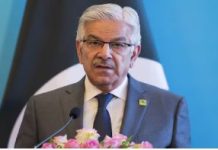Dr. Syed Javaid Khurshid
In 2015, 195 nations of the world agreed under the auspices of the United Nations(UN) to set out seventeen sustainable development goals to be achieved by 2030. If these goals are achieved it would have a lasting impact on the reduction of poverty &making health and education facilities more accessible for the common people in the less developed countries. All the countries agreed to adopt these goals that would improve the lives of their citizens through Agenda 2030. These countries have to work devotedly to achieve the goals as there is no plan B.
Global challenges have now become more complex after the outbreak of COVID-19. Working for sustainable development goals was being done effectively by many countries before the COVID-19 pandemic, but after this crisis, the targets are disturbed and seem difficult to be achieved by many countries by 2030. Many states have made commitments to achieve them at the national level. In 2015, Pakistan Planning Commission incorporated these SDGs in its national economic planning. The action plans and policies at the national level will play a fundamental role in countries’ development by translating these SDGs into workable actions, In Pakistan, national planning and incorporating the use of nuclear technology has played a significant role in achieving SDGs. It is good to remind ourselves on the 28thof May that nuclear energy has also been used for the betterment of the lives of Pakistanis and not only for making nuclear weapons.
It was recognized from the beginning by the planners in Pakistan that SDGs can be more easily achieved by involving science and scientific communities and adopting innovative technologies such as nuclear technology. Nuclear technology is guided and supported by the International Atomic Energy Agency (IAEA) internationally and the Pakistan Atomic Energy Commission (PAEC) nationally, which ensures it is safe for use.
Pakistan as a developing country is one of the largest recipients of technical and financial help from IAEA. Pakistan also has achieved considerable expertise in the application of nuclear technology for peaceful purposes and also using Nuclear technology in achieving 9 of 17 sustainable development goals. These goals are to Eradication of Hunger and Malnutrition, Provision of Good Health and Well-Being, Access to Clean Water and Sanitation facilities, Provision of Affordable and Clean Energy, Increase Industry Innovation and Infrastructure, Mitigation of Climate Change, Sustain Life Below Water, Sustain Life on Land, and Strengthening Partnerships for the achieving Sustainable Goals. These goals are in discussed in detail as below.
Eradication of Hunger and Malnutrition: In 2050, it is expected that the world population will grow to nearly 9.7 billion thus increasing our need for more food by 60% compared to the present. Currently, about 842 million people remain hungry every day and roughly about 1 billion people in the world are food insecure. There is, therefore, an urgent need to increase food production by atleast 60% to meet global needs. The Food and Agriculture Organization (FAO)has underscored that there is very little additional land available to grow more food crops. It requires that we must produce new varieties of crops which should be high-yielding, disease-resistant, drought and salt-tolerant and are suited to insect pest management.
In Pakistan, three institutes working under PAEC are using nuclear techniques to develop high-yielding varieties. Until now they have developed about 115 new varieties of different cash crops of national importance by radiation mutation. These crops at present cover about 35-40% of cultivable area, contributing about 10% to crop productivity. These are commendable achievements, but we need to continue our efforts to meet the ever-rising future requirements. Radiation sterilization technique such as Male Sterilization is also used for insect pest management to protect crops such as sugarcane crop in Sindh. Pakistan is also developing mutant varieties rich in iron and zinc micronutrients. A commercial irradiation facility in Lahore is helping to increase the shelf life of perishable food items by removing harmful bacteria and unwanted insects. Pakistan is also using stable isotopes to monitor body composition, food intake and absorption of various nutrients to understand the problems of malnutrition in the country.
Provision of Good Health and Well Being:People should be healthy so that they can work and support themselves and their families as well as contribute to the national economy. A healthy nation would be essential to achieve sustainable development goals. Nuclear techniques are most important in cancer treatment and management of some other fatal diseases using nuclear medicine, radiation oncology, radiation treatment and radiation diagnosis modalities. International Agency for Research in Cancer, estimates that about 150 million people are suffering from cancer globally. At present,Pakistan has about 30 cancer treatment facilities, whereas, 10 out of these have either diagnostic or treatment facilities. These facilities are catering to about 14,50,000 patients/year, Pakistan Atomic Energy Commission and Shaukat Khanum Hospital are playing a key role in cancer treatment in the country. In 2015, it was suggested by me to Planning Commission to establish a Cancer Control Program at the national level to achieve tertiary health care targets in the country. The program needs to be implemented in two phases and both phases should be implemented simultaneously. A very large number of cancer patients cannot be treated as they reach the hospital when the disease is already in an advanced stage. An early diagnosis of cancer patients would help the treatment and recovery of more patients afflicted by this malady. The allocation of funds for early diagnosis of cancer, therefore, is very important in controlling the disease. More importantly, cancer treatment facilities need to be doubled in the country. For this purpose, we need cancer diagnosis facilities after every 50 miles and treatment facilities after every 100 miles. Other than cancer diagnosis and radiation treatment, nuclear techniques are in use in the precise diagnosis of cardiovascular disease, tuberculosis, and in the diagnosis of many other infectious diseases. Nuclear techniques are also helping to detect and control outbreaks of animal diseases.
Access to Clean Drinking Water and Sanitation:Water is essential for life on the planet. Pakistan is already placed among the water-stressed countries. Besides access to clean water, the efficient use of water is also very important for the country and thus groundwater management and water conversation are needed. To achieve this goal Pakistan is utilizing nuclear isotopic techniques for collecting information such as age, amount and quality of groundwater which is very useful in integrated management of water resources and water ecosystem. Nuclear technology is also being used to make water bacteria-free.
Provision of Affordable and Clean Energy: Producing sufficient energy at an affordable cost without emitting greenhouse gases is a very important SDG. The energy production choices will have huge consequences for health, economy and climate change. World energy mix at present shows 65% fossil fuel, 16% Hydropower, 13% Nuclear power and 6-7% renewable energy. Besides Hydel, renewable and nuclear are the clean sources of energy. The most important thing is that nuclear energy is an uninterrupted clean source of energy. Recognizing the importance of nuclear energy first commercial nuclear power plant of the world was connected to grid in in 1956 at Calder Hall, England. At present, 31 countries are operating about 449 nuclear plants for electricity generation, whereas about 67 are under construction in 16 different countries. Pakistan recognized the importance of nuclear power from the beginning and built its first commercial power plant in 1971, K-1 of 137MW at Karachi. At present Pakistan is producing about 6% of its energy mix by 5 nuclear plants, which is going to increase upto 12% this year after K-2 in May and K-3 in October 2021 start operation at Karachi, Nuclear power is the answer to Pakistan’s future development, safety and security. Pakistan Atomic Energy Commission has already given a 40 years plan to the Government of Pakistan, of achieving a target of 8800 MW by 2030, and of 40,000 MW by 2048. The target of affordable and clean energy can only be achieved through nuclear energy, by installing more nuclear power projects on a Build Operate and Transfer (BOT) basis.
Sustainable Industry Innovation and Infrastructure: An excellent infrastructure and cutting-edge technologies are required to sustain and increase industrial growth. Nuclear technologies are contributing to achieving the indicators of this SDG by using Non-destructive X-ray techniques for quality testing of the products, such as welds, building and bridges and irradiation of wires, cables pipes and tyres to improve their quality and durability. Irradiation is also used to remove bacteria from medical products, sterilizing surgical instruments, and increasing the shelf life of food products such as onions potatoes, spices and mangoes. Pakistan has done a lot of research work in this direction and the first commercial irradiator was established in the country in 1987 at Lahore. At present two irradiators are working in Pakistan, one for single-use products and the other for food products, whereas another Electron Beam sterilization plant is coming up at Lahore. Here I would like to suggest to the government of Pakistan that we should install two Electron Beam irradiators at Gawader and one each at Gilgit and Karachi, their use will add value to our products and will increase our exports.
Mitigation of Climate Change: Temperature plays a very important role in food production and thus in the economy of the country which is affected by the release of greenhouse gases mainly carbon dioxide. All the leading nuclear think tanks and the research groups working on “nuclear for climate” programs in different countries agree that nuclear energy is the key in the fight against climate change. It is one of the leading reasons for considering an increase of nuclear power share in the country’s energy mix. As mentioned earlier Pakistan has chalked out an ambitious program to increase its nuclear energy production and thus help mitigate climate change.
Sustainability of Life Below Water: Protecting sea life is a significant SDG as marine life is one of the biggest and the cheapest sources of nutritious food for human beings. Marine life can be studied by using the powerful method of isotopic techniques. The isotopic techniques can help scientists to understand, monitor and control pollutants and protect marine health.
Sustainability of Life on Land: Land erosion is the biggest problem being faced the world over. About 1.5 million acres of soil is under erosion and degradation globally affecting the economy of several countries. Many countries are contributing to help control this menace by using nuclear and isotopic techniques. Nuclear techniques help to determine soil erosion rates. Based on these calculations remedial measures can be undertaken to restore soil, ecosystem and biodiversity. IAEA is supporting many countries in this field. Pakistan’s two research institutes are using these techniques in controlling the saline land which makes about 30% of the country’s cropping area.
Strengthening Partnership for achieving SDGs:To achieve SDGs partnerships have to be developed with international organizations such as UN, WHO,FAO and IAEA. In order to help achieve SDGs, the government of Pakistan should further strengthen the partnership between IAEA and PAEC.
Pakistans’ challenge is to achieve SDGs for the prosperity of the country. Nuclear techniques have played an important role in making progress on many fronts for achieving these goals. Pakistan is lucky to have scientific know-how and trained manpower in the field of nuclear technology. This advantage has been quite helpful in making steady progress in several areas as noted before. This should be further enhanced by IAEA’s support. Pakistan is already the highest recipient of financial and technical know-how from IAEA in Asia. There is a need to develop the political will to coherently move with the UN and IAEA for utilizing nuclear techniques to achieve sustainable development goals in the country by 2030.
Dr. Syed Javaid Khurshid is a Senior Research Fellow Centre of International Strategic Studies, Islamabad

















